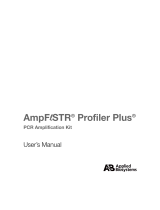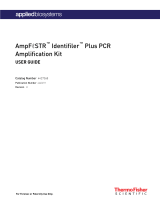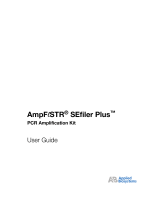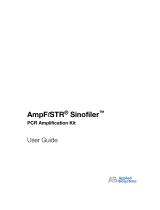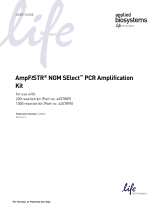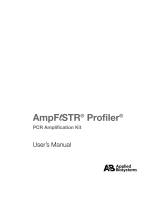Page is loading ...

DRAFT
December 18, 2002 10:15 am, 377
User Bulletin
ABI PRISM® 377 DNA Sequencer
December 2002
SUBJECT: Protocols for Processing AmpFlSTR® PCR
Amplification Kit PCR Products with the
ABI PRISM® 377 DNA Sequencer and Windows
NT OS
In This User
Bulletin
This user bulletin includes the following topics:
Safety. . . . . . . . . . . . . . . . . . . . . . . . . . . . . . . . . . . . . . . . . . . . . . . . . 2
Before You Begin . . . . . . . . . . . . . . . . . . . . . . . . . . . . . . . . . . . . . . . 7
Equipment and Supplies Required . . . . . . . . . . . . . . . . . . . . . . . . . 10
Preparing 36-cm Well-to-Read Gel Plates . . . . . . . . . . . . . . . . . . . 16
Setting Up the Instrument for Filter Set G5 . . . . . . . . . . . . . . . . . . 27
Setting Up the Instrument for Filter Set F. . . . . . . . . . . . . . . . . . . . 39
Electrophoresis . . . . . . . . . . . . . . . . . . . . . . . . . . . . . . . . . . . . . . . . 51
Analyzing the Data . . . . . . . . . . . . . . . . . . . . . . . . . . . . . . . . . . . . . 59
Overview AmpFlSTR PCR Amplification Kit products are run on 36-cm well-
to-read plates on the ABI PRISM® 377 DNA Sequencer
(ABI PRISM 377), the ABI PRISM 377 DNA Sequencer with XL
Upgrade (ABI PRISM 377XL), or the ABI PRISM 377 DNA
Sequencer with 96-Lane Upgrade (ABI PRISM 377-96). Protocols for
analyzing samples on these configurations with the Microsoft®
Windows NT® operating system are included in this user bulletin.

DRAFT
December 18, 2002 10:15 am, 377 NT_UB_NewTemplate.fm
2 Protocols for AmpF
l
STR® PCR Amplification Kits with the ABI PRISM® 377 and Windows NT
Safety
Safety Conventions Used in This Document
Safety Alert
Words
Four safety alert words appear in Applied Biosystems user
documentation. Each word implies a particular level of observation
or action, as described below:
IMPORTANT! Indicates information that is necessary for proper
instrument operation, accurate chemistry kit use, or safe use of a
chemical.
Indicates a potentially hazardous situation that, if
not avoided, can result in minor or moderate injury. It can also alert
against unsafe practices, damage to an instrument, or loss of data.
Indicates a potentially hazardous situation that, if
not avoided, can result in serious injury or death.
Indicates an imminently hazardous situation that,
if not avoided, will result in serious injury or death. This signal word
is to be limited to the most extreme situations.
Chemical Safety
Chemical Hazard
Warning
CHEMICAL HAZARD. Some of the chemicals
used with Applied Biosystems instruments and protocols are
potentially hazardous and can cause injury, illness, or death.

DRAFT
December 18, 2002 10:15 am, 377 NT_UB_NewTemplate.fm
Safety
Protocols for AmpF
l
STR® PCR Amplification Kits with the ABI PRISM® 377 and Windows NT 3
Chemical Safety
Guidelines
To minimize the hazards of chemicals:
• Read and understand the MSDSs provided by the chemical
manufacturer before you store, handle, or work with any
chemicals or hazardous materials. See “About MSDSs.”
• Minimize contact with chemicals. When handling chemicals,
wear appropriate personal protective equipment such as safety
glasses, gloves, and protective clothing. For additional safety
guidelines, consult the MSDS.
• Minimize the inhalation of chemicals. Do not leave chemical
containers open. Use only with adequate ventilation (for
example, a fume hood). For additional safety guidelines, consult
the MSDS.
• Check regularly for chemical leaks or spills. If a leak or spill
occurs, follow the cleanup procedures recommended in the
MSDS.
• Comply with all local, state/provincial, or national laws and
regulations related to chemical storage, handling, and disposal.
About MSDSs Chemical manufacturers supply current Material Safety Data Sheets
(MSDSs) with shipments of hazardous chemicals to new customers.
They also provide MSDSs with the first shipment of a hazardous
chemical to a customer after an MSDS has been updated. MSDSs
provide the safety information you need to store, handle, transport,
and dispose of the chemicals safely.
Each time you receive a new MSDS packaged with a hazardous
chemical, be sure to replace the appropriate MSDS in your files.

DRAFT
December 18, 2002 10:15 am, 377 NT_UB_NewTemplate.fm
4 Protocols for AmpF
l
STR® PCR Amplification Kits with the ABI PRISM® 377 and Windows NT
Obtaining MSDSs You can obtain from Applied Biosystems the MSDS for any chemical
supplied by Applied Biosystems. This service is free and available 24
hours a day.
To obtain MSDSs:
1. Go to https://docs.appliedbiosystems.com/msdssearch.html.
2. In the Search field, type in the chemical name, part number, or
other information that appears in the MSDS of interest. Select
the language of your choice, then click Search.
3. Find the document of interest, right-click the document title,
then select any of the following:
•Open – To view the document
•Print Targe t – To print the document
•Save Target As – To download a PDF version of the
document to a destination that you choose
4. To have a copy of a document sent by fax or e-mail, select Fax
or Email to the left of the document title in the Search Results
page, then click RETRIEVE DOCUMENTS at the end of the
document list.
5. After you enter the required information, click View/Deliver
Selected Documents Now.
Chemical Waste Safety
Chemical Waste
Hazard
CHEMICAL WASTE HAZARD. Some wastes
produced by the operation of the instrument or system are potentially
hazardous and can cause injury, illness, or death.
Chemical Waste
Guidelines
To minimize the hazards of chemical waste:
• Read and understand the MSDSs for the chemicals in a waste
container before you store, handle, or dispose of chemical waste.
• Provide primary and secondary waste containers.
• Minimize contact with and inhalation of chemical waste. When
handling chemicals, wear appropriate personal protective
equipment such as safety glasses, gloves, and protective
clothing.
• Handle chemical wastes in a fume hood.

DRAFT
December 18, 2002 10:15 am, 377 NT_UB_NewTemplate.fm
Safety
Protocols for AmpF
l
STR® PCR Amplification Kits with the ABI PRISM® 377 and Windows NT 5
• After you empty a chemical waste container, seal it with the cap
provided.
• Dispose of the contents of a waste container in accordance with
good laboratory practices and local, state/provincial, and/or
national environmental and health regulations.
Site Preparation
and Safety Guide
A site preparation and safety guide is a separate document sent to all
customers who have purchased an Applied Biosystems instrument.
Refer to the guide written for your instrument for information on site
preparation, instrument safety, chemical safety, and waste profiles.
Waste profiles help you plan for the handling and disposal of waste
generated by operation of the instrument. Read the waste profiles and
all applicable MSDSs for your instrument before handling or
disposing of chemical waste.
Waste Disposal If potentially hazardous waste is generated when you operate the
instrument, you must:
• Characterize (by analysis if necessary) the waste generated by
the particular applications, reagents, and substrates used in your
laboratory.
• Ensure the health and safety of all personnel in your laboratory.
• Ensure that the instrument waste is stored, transferred,
transported, and disposed of according to all local,
state/provincial, and/or national regulations.
Note: Radioactive or biohazardous materials may require special
handling, and disposal limitations may apply.

DRAFT
December 18, 2002 10:15 am, 377 NT_UB_NewTemplate.fm
6 Protocols for AmpF
l
STR® PCR Amplification Kits with the ABI PRISM® 377 and Windows NT
Biological Hazard Safety
BIOHAZARD. Biological samples such as
tissues, body fluids, and blood of humans and other animals have the
potential to transmit infectious diseases. Follow all applicable local,
state/provincial, and/or national regulations. Wear appropriate
protective eyewear, clothing, and gloves. Read and follow the
guidelines in these publications:
• U.S. Department of Health and Human Services guidelines
published in Biosafety in Microbiological and Biomedical
Laboratories (stock no. 017-040-00547-4,
http://bmbl.od.nih.gov)
• Occupational Safety and Health Standards, Bloodborne
Pathogens (29 CFR §1910.1030,
http://www.access.gpo.gov/nara/cfr/waisidx_01/29cfr1910a_01.
html)
Additional information about biohazard guidelines is available at:
http://www.cdc.gov

DRAFT
December 18, 2002 10:15 am, 377 NT_UB_NewTemplate.fm
Before You Begin
Protocols for AmpF
l
STR® PCR Amplification Kits with the ABI PRISM® 377 and Windows NT 7
Before You Begin
Software
Requirements
This user bulletin is written for:
• ABI PRISM® Data Collection Software v3.0 (PN 4326986)
• ABI PRISM® GeneScan® Analysis Software Version 3.7.1 or
higher
Before using the ABI PRISM 377, ABI PRISM 377XL, or
ABI PRISM 377-96, you must install the appropriate software. The
associated documentation is listed below.
AmpFlSTR Kits The protocols in this user bulletin are applicable to all AmpFlSTR
kits.
Table 1 Software documentation
Software Part
Number
ABI PRISM® 377 DNA Sequencer User Guide For Data
Collection Software on the Windows NT® Platform
4325703
ABI PRISM® GeneScan® Analysis Software Version 3.7
for the Windows NT® Platform User Guide
4308923
ABI PRISM® GeneScan Analysis Software Version 3.7.1
User Bulletin
4335617
Table 2 AmpFlSTR Kits and Part Numbers
AmpFlSTR Kits Source
AmpFlSTR® Blue™ PCR Amplification Kit
(PN 402800) Applied Biosystems
AmpFlSTR® COfiler® PCR Amplification Kit
(PN 4305246) Applied Biosystems
AmpFlSTR® Green™ I PCR Amplification Kit
(PN 402902) Applied Biosystems
AmpFlSTR® Identifiler® PCR Amplification Kit
(PN 4322288 Applied Biosystems

DRAFT
December 18, 2002 10:15 am, 377 NT_UB_NewTemplate.fm
8 Protocols for AmpF
l
STR® PCR Amplification Kits with the ABI PRISM® 377 and Windows NT
Equipment and
Supplies
The equipment and supplies necessary or recommended for running
AmpFlSTR kit data on the ABI PRISM 377 instruments are listed in
the tables under “Equipment and Supplies Required” on page 10.
Related
Documentation
Refer to the documents listed below for more detailed information on
the instrument and software used with these protocols:
• ABI PRISM®377 DNA Sequencer with 96-Lane Upgrade User
Bulletin (4313688)
• ABI PRISM®377 DNA Sequencer 96-Lane Upgrade User’s
Manual (4305423)
• ABI PRISM® 377 Gel Processor Software User Guide (PN
4317592)
•AmpFlSTR® Blue™ PCR Amplification Kit User’s Manual
(PN 402827)
•AmpFlSTR® COfiler® PCR Amplification Kit User Bulletin
(PN 4305469)
•AmpFlSTR® Green™ PCR Amplification Kit User’s Manual
(PN 402944)
•AmpFlSTR® Identifiler® PCR Amplification Kit User’s Manual
(PN 432391)
•AmpFlSTR® Profiler® PCR Amplification Kit User’s Manual
(PN 402945)
•AmpFlSTR® Profiler Plus™ PCR Amplification Kit User’s
Manual (PN 4303501)
AmpFlSTR Kits Source
AmpFlSTR® Profiler® PCR Amplification Kit
(PN 403038) Applied Biosystems
AmpFlSTR® Profiler Plus™ PCR Amplification
Kit (PN 4303326) Applied Biosystems
AmpFlSTR® SEfiler™ PCR Amplification Kit
(PN 4335129) Applied Biosystems
AmpFlSTR® SGM Plus® PCR Amplification Kit
(PN 4307133) Applied Biosystems
Table 2 AmpFlSTR Kits and Part Numbers

DRAFT
December 18, 2002 10:15 am, 377 NT_UB_NewTemplate.fm
Before You Begin
Protocols for AmpF
l
STR® PCR Amplification Kits with the ABI PRISM® 377 and Windows NT 9
•AmpFlSTR® SEfiler™ PCR Amplification Kit User’s Manual
(PN 4337410)
•AmpFlSTR® SGM Plus® PCR Amplification Kit User’s
Manual (PN 4309589)

DRAFT
December 18, 2002 10:15 am, 377 NT_UB_NewTemplate.fm
10 Protocols for AmpF
l
STR® PCR Amplification Kits with the ABI PRISM® 377 and Windows NT
Equipment and Supplies Required
Dedicated
Equipment and
Supplies
Follow the guidelines for dedicated equipment and supplies to ensure
that exogenous DNA and PCR products are confined to designated
areas:
• Designate a work area and dedicated equipment and supplies
used for amplified DNA. Do not remove amplified DNA,
equipment, or supplies from this work area.
• Samples that are not amplified should never come into contact
with supplies and equipment in the amplified DNA work area.
Required
Equipment
The equipment necessary or recommended for running AmpFlSTR
kit data on the ABI PRISM 377, 377XL, and 377-96 DNA Sequencer
instruments is listed in the table below. You can order the part
numbers listed below from Applied Biosystems. If no part number is
listed, you can order from any major laboratory supplier (MLS).
Table 3 Equipment required
Equipment Source
•ABIP
RISM® 377 DNA Sequencer
•ABIPRISM®377 DNA Sequencer with
XL Upgrade, or
•ABIPRISM®377 DNA Sequencer with
96-Lane Upgrade
Applied Biosystems
Thermal cycler:
• GeneAmp® PCR System 9700
• GeneAmp® PCR System 9600
• GeneAmp® PCR System 2400
• DNA Thermal Cycler 480
Applied Biosystems
For ordering information,
see your Applied
Biosystems sales
representative.
Autoclave MLS
Benchkote absorbent protector sheets MLS
Conductivity meter MLS
Freezer, –15 to –25 °C, non-frostfree MLS
Glassware MLS

DRAFT
December 18, 2002 10:15 am, 377 NT_UB_NewTemplate.fm
Equipment and Supplies Required
Protocols for AmpF
l
STR® PCR Amplification Kits with the ABI PRISM® 377 and Windows NT 11
Gloves, disposable, powder-free MLS
Ice bucket MLS
Lab coat MLS
Lamp, 27-inch gooseneck with magnetic
base
Sunnex, PN 701-27, or
office supply store
Lint-free tissues MLS
Magnetic stir plate and stir bar MLS
Microcentrifuge MLS
Microtube racks MLS
Nalgene filter apparatus, 150-mL, 0.2-µm
CN filter
MLS
Needles for the two-pitch, eight-channel
loader, 0.01-in., 0.25-mm point
Kloehn
(PN 18663, 8 needles)
World Precision
Instruments
(PN 67126, 10 needles)
pH meter MLS
Pipet bulb MLS
Pipets, serological MLS
Pipet tips for gel loading, 0.2 mm flat tips
(Rainin, PN GT1514)
MLS
Pipet tips, sterile, disposable
hydrophobic filter-plugged
MLS
Pipettors, adjustable, 0.5–10 µL, 2–20 µL,
20–200 µL, and 200–1000 µL
MLS
Plastic wrap MLS
Razor blades MLS
Table 3 Equipment required (continued)
Equipment Source

DRAFT
December 18, 2002 10:15 am, 377 NT_UB_NewTemplate.fm
12 Protocols for AmpF
l
STR® PCR Amplification Kits with the ABI PRISM® 377 and Windows NT
Refrigerator MLS
Repeat pipettor and Combitips that
dispense 1–5 µL (optional)
MLS
Sink MLS
Syringe, 20- or 35-cc (optional) MLS
Tacks Office supplier
Tube decapper, autoclavable MLS
Two-pitch, eight-channel loader, 0.25-mm Kloehn Company
(PN 18597)
World Precision
Instruments
(PN GelMate96)
Vortexer MLS
Water bath, 37 °CMLS
Table 3 Equipment required (continued)
Equipment Source

DRAFT
December 18, 2002 10:15 am, 377 NT_UB_NewTemplate.fm
Equipment and Supplies Required
Protocols for AmpF
l
STR® PCR Amplification Kits with the ABI PRISM® 377 and Windows NT 13
Required
Supplies
The supplies necessary or recommended for running AmpFlSTR kit
data on the ABI PRISM 377, 377XL, and 377-96 DNA Sequencer
instruments are listed in the table below. You can order the part
numbers listed below from Applied Biosystems. If no part number is
listed, you can order from any major laboratory supplier (MLS).
Table 4 Supplies required
Supplies Source
ABI PRISM 377 DNA Sequencer
Accessories:
• 36-cm well-to-read plates:
– 36-cm rear glass plate
(PN 401839)
– 36-cm front glass plate
(PN 401840)
– 36-cm step plate for 96 wells
(PN 4305384)
– 36-cm gel spacers, 0.2 mm
thick (PN 401836)
Applied Biosystems
Combs:
• 34-well square tooth comb, 0.2
mm thick (PN 401907)
• 50-well square tooth comb, 0.2
mm thick (PN 402053)
• 96-lane Mylar shark’s tooth
comb, 0.4 mm (PN 4305385)
• optional: 24-well square tooth
comb, 0.2 mm thick
(PN 401904)
Applied Biosystems
GeneAmp® Thin-Walled Reaction
Tubes with Caps, 0.5-mL
(PN N8010737)
Applied Biosystems
MicroAmp® Caps, 8 caps/strip
(PN N8010535)
Applied Biosystems
MicroAmp® 8-Strip Reaction
Tubes (PN N8010580)
Applied Biosystems
MicroAmp® Optical 96-Well
Reaction Plate (PN N8010560)
Applied Biosystems

DRAFT
December 18, 2002 10:15 am, 377 NT_UB_NewTemplate.fm
14 Protocols for AmpF
l
STR® PCR Amplification Kits with the ABI PRISM® 377 and Windows NT
Required
Chemicals and
Reagents
The chemicals and reagents necessary or recommended for running
AmpFlSTR kit data on the ABI PRISM 377, 377XL, and 377-96 DNA
Sequencer instruments are listed in the table below. You can order the
part numbers listed below from Applied Biosystems. If no part
number is listed, you can order from any major laboratory supplier
(MLS).
MicroAmp® 96-Well Full Plate
Covers (PN N8010550)
Applied Biosystems
Stainless steel gel clamp (large), 1
each (PN 4305386)
Applied Biosystems
Filter units, Nalgene
(150-mL, 0.2-µm CN filter)
MLS
Filter units, Nalgene (150-mL,
0.2-µm or 0.45-µm nylon filter)
MLS
Lint-free tissues or dedicated wash
cloth
MLS
Table 4 Supplies required (continued)
Supplies Source
Table 5 Chemicals and reagents required
Equipment Supplier
Blue dextran “Loading Buffer” (contained in
GeneScan-500 LIZ or GeneScan-500XL ROX
Size Standard Kit) (PN 402055)
Applied Biosystems
GeneScan-500 LIZ Size Standard Kit
(PN 4322682) Applied Biosystems
GeneScan-500XL ROX Size Standard Kit
(PN 403039)
Note This kit includes blue dextran loading
buffer.
Applied Biosystems
Hi-Di™ Formamide, 24 mL (PN 4311320) Applied Biosystems

DRAFT
December 18, 2002 10:15 am, 377 NT_UB_NewTemplate.fm
Equipment and Supplies Required
Protocols for AmpF
l
STR® PCR Amplification Kits with the ABI PRISM® 377 and Windows NT 15
Either:
Matrix Standard Set DS-32 for the 377 and
310 instrument platforms (PN 4312131),
or
Matrix Standard Set DS-33 for the 377 and
310 instrument platforms (PN 4318159)
Applied Biosystems
TBE, 5X (see “Preparation of Required
Reagents” on page 24)
Applied Biosystems
AG501 X8 ion exchange resin BioRad
Alconox detergent MLS
Ammonium persulfate (APS) MLS
Disodium ethylenediaminetetraacetate,
dihydrate (Na2EDTA•2H20) (MLS)
MLS
Long Ranger, 50% stock solution
(BioWhittaker Molecular Applications,
PN 50610, 50611)
FMC Bioproducts
N,N,N´,N´-Tetramethylethylenediamine
(TEMED)
MLS
Sodium hydroxide pellets (NaOH) MLS
Tris base (MLS) MLS
Urea MLS
Water, glass distilled, deionized MLS
Table 5 Chemicals and reagents required (continued)
Equipment Supplier

DRAFT
December 18, 2002 10:15 am, 377 NT_UB_NewTemplate.fm
16 Protocols for AmpF
l
STR® PCR Amplification Kits with the ABI PRISM® 377 and Windows NT
Preparing 36-cm Well-to-Read Gel Plates
Preparing Plates The 36-cm well-to-read gel plates must be cleaned and prepared by
following the instructions below.
ABI PRISM 377 and the ABI PRISM 377-96
To prepare 36-cm well-to-read plates for the 377 and the 377-96:
1. Clean 36-cm well-to-read gel plates with Alconox detergent
using a dedicated wash cloth or lint-free tissues.
To obtain the MSDS for Alconox, go to:
http://www.jtbaker.com/asp/Catalog.asp
2. Rinse the plates with deionized water, and allow the plates to
air dry.
3. Place the larger, unnotched plate with the center etch facing
down on a covered bench top.
Note: The narrow width is the bottom portion of the plate.
4. Place 0.2-mm spacers on either side of the plate so that:
• The notched end of the spacer is at the top of the plate
• The notch faces the center of the plate
5. Place the notched, “rabbit-eared” plate over spacers.
Make sure that the external side of the plate:
• Is the one that was previously in contact with the
silicone rubber gasket of the upper buffer chamber
• Contains etched writing

DRAFT
December 18, 2002 10:15 am, 377 NT_UB_NewTemplate.fm
Preparing 36-cm Well-to-Read Gel Plates
Protocols for AmpF
l
STR® PCR Amplification Kits with the ABI PRISM® 377 and Windows NT 17
ABI PRISM 377XL
When preparing plates for the ABI PRISM 377 analyzer with the XL
Upgrade, you must silanize the plates. Treat the well-forming region
of the notched (rabbit-eared) glass plate with Bind-Silane to
immobilize the wells and facilitate subsequent loading of the gel by
following the instructions in the table below.
6. Clamp plates together with four medium binder clips (for the
377 and 377XL formats) or four large stainless steel gel
clamps (for the 377-96 lane format) on each side:
• Place the clamps directly over the spacers.
• Distribute the clamps for even tightening across the gel.
7. Elevate the top end of plates approximately 1.0 cm.
Note: A pipette-tip box top can be used to elevate the plates.
To prepare 36-cm well-to-read plates for the 377XL:
1. Clean 36-cm well-to-read gel plates with Alconox detergent
using a dedicated wash cloth or lint-free tissues. Rinse with
deionized water and air dry.
To obtain the MSDS for Alconox, go to:
http://www.jtbaker.com/asp/Catalog.asp
2. Place the cleaned, notched (rabbit-eared) glass plates face up
on a covered benchtop.
3. Dip the end of a cotton swab into a bottle of Bind-Silane to
wet the tip.
Obtain the MSDS for Bind-Silane from the manufacturer.
IMPORTANT! Apply a fresh coating of Bind-Silane every
time you clean gel plate.
To prepare 36-cm well-to-read plates for the 377 and the 377-96:

DRAFT
December 18, 2002 10:15 am, 377 NT_UB_NewTemplate.fm
18 Protocols for AmpF
l
STR® PCR Amplification Kits with the ABI PRISM® 377 and Windows NT
4. Transfer the Bind-Silane to the well-forming region of the
notched glass plate (approximately the top 1.0 cm of the
plate) by swiping the swab across the plate three times.
Note: Do not treat the side that had been previously in
contact with the silicon rubber gasket of the upper buffer
chamber.
5. Allow the Bind-Silane to dry on the plate for 1 minute.
6. Dry the treated region with a lint-free tissue by wiping three
times using moderate pressure.
7. Assemble the plates. Place the larger, unnotched plate with
the center etch facing down on a covered bench top.
Note: The narrow width is the bottom portion of the plate.
8. Place 0.2-mm spacers on either side of the plate so that:
• The notched end of the spacer is at the top of the plate
• The notch faces the center of the plate
9. Place the notched, “rabbit-eared” plate over spacers.
Make sure that the external side of the plate:
• Is the one that was previously in contact with the
silicone rubber gasket of the upper buffer chamber
• Contains etched writing
10. Clamp plates together with four medium binder clips on each
side:
• Place the clamps directly over the spacers.
• Distribute the clamps for even tightening across the gel.
11. Elevate the top end of plates approximately 1.0 cm.
Note: A pipette-tip box top can be used to elevate the plates.
12. After running the gel, clean the plates using Alconox
detergent. It may be necessary to scrape the gel off the
notched plate where it has stuck to the Bind-Silane-treated
region.
To prepare 36-cm well-to-read plates for the 377XL: (continued)

DRAFT
December 18, 2002 10:15 am, 377 NT_UB_NewTemplate.fm
Preparing 36-cm Well-to-Read Gel Plates
Protocols for AmpF
l
STR® PCR Amplification Kits with the ABI PRISM® 377 and Windows NT 19
Preparing Gels Applied Biosystems recommends using Long Ranger® gel solutions
instead of 4% acrylamide for 36-cm well-to-read gels. Long Ranger
gels form better wells around the comb, facilitating loading and
potentially enhancing results. The following procedure for preparing
50 mL of 5% Long Ranger/6.0 M urea gel mixture makes enough gel
mixture for two 36-cm well-to-read gels.
Read the warnings listed below before proceeding.
CHEMICAL HAZARD. Urea is a possible
mutagen. Do not breathe the dust. Urea can be harmful by inhalation,
skin contact, and ingestion. Refer to the MSDS for proper protective
equipment.
CHEMICAL HAZARD. TBE 5X buffer causes
eye, skin, and respiratory tract irritation. Exposure may cause central
nervous system depression and kidney damage. Read the MSDS, and
follow the handling instructions. Wear appropriate protective
eyewear, clothing, and gloves.
CHEMICAL HAZARD. Long Ranger gel
solution contains acrylamide. Acrylamide is a neurotoxin. Avoid skin
contact with Long Ranger gel solution because acrylamide can be
absorbed through the skin. Always work in a fume hood. Obtain a
copy of the MSDS from the manufacturer. Wear appropriate
protective eyewear, clothing, and gloves.
CHEMICAL HAZARD. Ammonium
persulfate is an oxidizer, and contact with other materials may cause
a fire. Exposure causes burns to the eyes, skin, and respiratory tract.
Read the MSDS, and follow the handling instructions. Wear
appropriate protective eyewear, clothing, and gloves.
CHEMICAL HAZARD. TEMED is extremely
flammable, and can be very destructive to the skin, eyes, nose, and
respiratory system. Keep TEMED in a tightly closed container. Avoid
inhalation and contact with the skin, eyes, and clothing. Always work
in a fume hood. Obtain a copy of the MSDS from the manufacturer.
Wear appropriate protective eyewear, clothing, and gloves.

DRAFT
December 18, 2002 10:15 am, 377 NT_UB_NewTemplate.fm
20 Protocols for AmpF
l
STR® PCR Amplification Kits with the ABI PRISM® 377 and Windows NT
To prepare the gel mixture:
1. Combine the following:
Urea 18.0 g
Deionized water 21.5 mL
5X TBE (Maniatis formulation)* 10.0 mL
50% Long Ranger stock solution 5.0 mL
*See “Preparation of Required Reagents” on page 24.
2. Warm the mixture in a 37 °C water bath, stirring
occasionally, to dissolve the urea. Once the urea is
dissolved, allow the gel mixture to equilibrate to room
temperature. This gel mixture should be used within 12 h.
Keep the gel mixture covered during this step to prevent
evaporative loss.
3. Filter the gel mixture using a 150-mL Nalgene filter
apparatus with a 0.2 µm CN filter. Attach to a vacuum
source (approximately 20 inches Hg) to pull liquid through
filter. This step removes any particulates that may
fluoresce or scatter light.
4. Let stand for 5 min, swirling occasionally, with the vacuum
on to degas the mixture.
5. Turn off the vacuum, remove the top of the filter apparatus,
and discard.
The filter apparatus can be rinsed thoroughly with
deionized water and air-dried to be reused up to five times.
6. Add 250 µL of freshly prepared 10% APS and 35 µL
TEMED to the gel mixture. Swirl gently to mix.
Immediately proceed to “Pouring Gels” on page 21.
/
